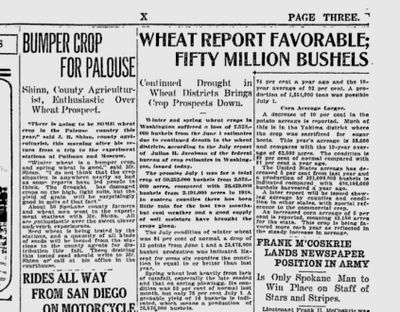100 years ago in Eastern Washington: Grains top production of Spokane region

The products of the Inland Empire in 1919 were projected to total $250 million, said the Spokane Chamber of Commerce.
Here were the top categories, in order.
1. Grains, totaling $105 million. The chamber estimated the region produced one-ninth of the total wheat crop in the U.S.
2. Minerals, at $93 million. The region produced one-third of the nation’s lead supply.
3. Livestock and poultry, $27 million.
4. Lumber, $25 million.
5. Farm and garden products, $20 million.
6. Apples and other fruits, $15 million.
7. Dairy products, $15 million.
From the soldier beat: Edwin Lavigne, a Spokane man who enlisted in the British army’s Royal Engineers in 1917, wrote home to tell his parents that he will be heading home with the “first available boat,” which he jokingly said, “means within the year.” He was currently in London.
Lavigne had already had an exciting time on the voyage from Mesopotamia (today’s Iraq) to London. He sailed in the hold of a small cargo boat through the Indian Ocean, with “temperature around 105, the humidity around a thousand,” and no porthole to open. But, he said, “we stuck it out easily.”
He told his parents that he left Mesopotamia with $250, but he “managed to spend or lose” most of it.
“The last day of my leave, I am going to put what I have left on a horse race,” he write. “If I lose – back to camp. If I win, I will get extension of leave and stay here.”